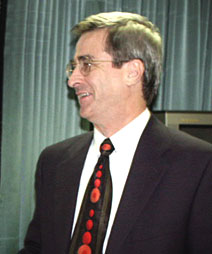|
| Magriel's NYT Columns |

Hugh Sconyers The California Open Backgammon Championships, under the direction of Sidney Jackson and George Bassman, took place this month in Los Angeles. A special feature of this event, which drew 422 players, was a “double elimination” format that enabled competitors who had lost a round to remain in contention.
In the finals, Hugh Sconyers overcame George Zehler to take first place. Sconyers, considered one of the West Coast’s best players has a fine tournament record. Recently he became owner of the Cavendish West club in Los Angeles, the major center of backgammon activity in the area.
Other results: Manny Delos and Mike Corbett placed third and fourth. Bill Arkin took the consolation flight, and Jim Gibbs won the last-chance competition. In the intermediate section, Dayril Marcus was the victor, and Russell Young triumphed in the beginners’ group.
The diagrammed position illustrates a key position in the last game of the closely contested 25-point final match between Sconyers and Zehler. Zehler had lost one round; Sconyers had lost none. This meant that, according to the double elimination rules, if Sconyers lost this match the two would have to meet again for yet a second bout.
The score was now 23–22, Sconyers. In the diagram, Zehler (White) has already doubled and is now in a favorable position — he has only one man left (on the 5-point) to bring home.
|
22
MATCH TO 25 23 |
| Black to play 2-1. |
Instead, Sconyers decided to make an aggressive but highly risky play in an attempt to contain White. He correctly played 6/5*, 10/8, hitting White “loose” on the 5-point and splitting the men on the 10-point.
|
|
|
In the actual game, White came back with a devastating shot. He rolled a 4-1 and played bar/1*/5*, reentering on the 1-point and hitting a second man on the 5-point.
|
|
The fallback strategy worked out. During the bearoff, White was forced to leave a man exposed, and Black hit it. Because Black had managed to keep his home board intact, he succeeded in closing White out. Sconyers easily won the game to take the match, 25–22.
Rollout
 Tom Keith 2013 |
|
Match to 25 White 22, Black 23 Black owns 2-cube Black rolls 2-1 1296 games with VR Checker play: 2-ply Cube play: 3-ply Red |
| 2-1: | Game | G | BG | Equity | ||||
| 1 | 13/11, 6/5* |
W L |
.3581 .6419 |
.0235 .3287 |
.0015 .1519 | −0.5969 |

| |
| 2 | 10/8, 6/5* |
W L |
.3613 .6387 |
.0199 .3534 |
.0007 .1828 | −0.6140 | (0.0171) | (b) |
| 3 | 6/5*/3 |
W L |
.2718 .7282 |
.0097 .2458 |
.0002 .0752 | −0.6905 | (0.0936) | |
| 6 | 13/10 |
W L |
.1495 .8505 |
.0050 .1633 |
.0001 .0174 | −0.8567 | (0.2598) | (a) |

|
|

